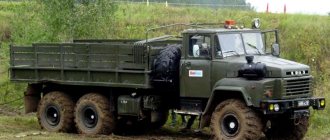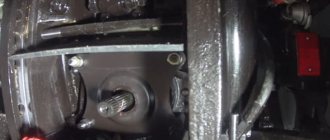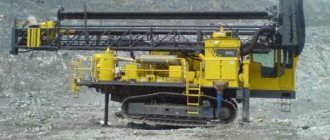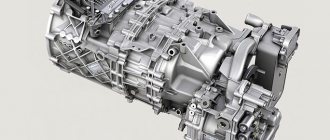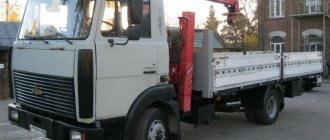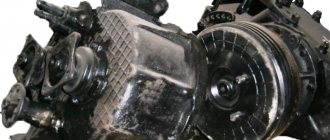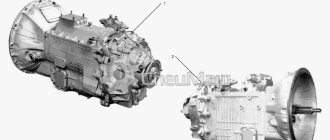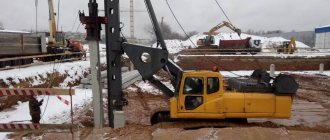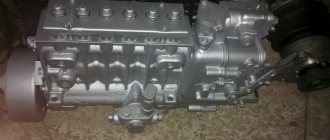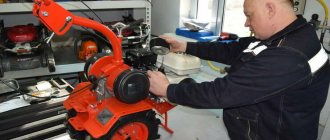ZIL 131 cars are classics of the Soviet automobile industry. It is worth noting that this particular vehicle is the truck of our army, and it was in service that the chassis confirmed its stable operation and highest reliability, working flawlessly in the steppes of Central Asia and the snows of Yakutia. In 1974, the car was awarded the State Quality Mark.
Over time, the ZIL car became a real assistant for civil organizations. One has only to remember the classic look of the fire truck, which was made precisely on its basis. The phenomenal longevity of the car became possible as a result of a tandem of a number of important qualities and characteristics. 6-wheel drive, powerful V8 engine, good off-road performance, resistance to breakdowns and a wide variety of tasks that it can handle without any problems.
And one of these tasks was drilling. The ZIL 131 drilling rig is distinguished by its versatility and simplicity of design. On this chassis, the Drilling Technologies Plant produces one of the most common rigs - URB-2A2. The ZIL drilling rig of this modification is the most optimal option for drilling during geological and geophysical research, water drilling, searching for oil, gas and other mineral deposits for construction and engineering work.
Drilling rig PBU-2
| Drilling crew No. 1 PBU-2 based on ZIL-131 |
PBU-2 can be installed on various vehicles: off-road vehicles and chassis such as AMUR (ZIL-131), URAL, KamAZ, transport tracked vehicle TGM-126, MTLBu, tractors TT-4 and TLT-100A, on a sled base and others chassis.
Operation of the machine is allowed in areas with a temperate climate in the temperature range from minus 40*C to plus 40*C. The movable rotator of the installation is driven by the drive shaft from the transmission of the installation and moves along the mast guides by hydraulic cylinders of the feed mechanism. The mast is tubular with an open front edge. Planetary winch with free discharge for percussion-rope drilling, rope capacity - 60 m, rope diameter - 14 mm. The version without a winch is intended for work that does not require well casing, without the use of a driving glass.
It can be equipped with a crank balancer with a stroke of 550 mm. The version with a balancer allows you to work on the installation with a driving glass and carry out test pumping of water and driving of casing pipes.
Main capabilities of the PBU-2 drilling rig:
- drilling engineering-geological and technical wells using the percussion-rope method
- drilling wells during the construction of piles and sheet pilings (including with equal augers)
- drilling seismic wells
- excavation of exploration pits in loose alluvial deposits
- Dry rotary core drilling (without the use of a cleaning agent)
- rotary core and coreless drilling with flushing of geological exploration, hydro- and engineering-geological, technical wells
- rotary core and coreless drilling with bottom hole cleaning with compressed air for geological exploration, hydro- and engineering-geological, technical wells
- impact-rotary core and coreless drilling using downhole pneumatic hammers with bottom hole cleaning with compressed air for geological exploration, hydro- and engineering-geological , technical wells
- performing engineering-geological surveys through static probing of soils (clays, loams and sands)
Specifications
| Type of drilling | Diameter (mm) | Drilling depth (m) | Bit diameter (mm) |
| Rotary screws | 135 | 50 (60 for PBU-3) | 148 |
| Rotary screws | 180 | 50 (60 for PBU-3) | 198 |
| Rotary screws | 230 | 25 (30 for PBU-3) | 250 |
| Auger drill | 650 | up to 20 | 650 |
| Auger drill | 850 | up to 20 | 850 |
| Core pipe “dry” on special rods | 73 | 50 | 1087 |
| Core drill pipe with direct flushing | 50 | 100 | 132 |
| Shock-rope | impact-driving glass | 50 | 135 |
| Shock-rope | jelliing | 50 | 1087 |
Mobile drilling rig AVB-2M
| Drilling crew No. 3 AIB-2M based on GAZ-66 |
The AVB-2M vibration drilling installation is designed for drilling vertical wells during engineering and construction surveys using the vibration method in rocks of categories I-IV in terms of drillability and for drilling wells using the percussion-rope method in rocks up to category VII in terms of drillability.
The AVB-2M vibration drilling unit is a self-propelled transport unit mounted on the chassis of a GAZ-33081 or GAZ-66 vehicle. The necessary drilling tools and equipment for vibration drilling of wells are loaded onto it.
The tackle equipment, if necessary, can be easily converted from single-string to double-string.
Impact-rope drilling with an annular face can be carried out using the percussion method with a downhole impact cartridge, the “pecking” method with a weighted impact rod, and the bailer method with a bailer with a valve.
The standard package of the AVB-2M installation includes a drilling tool. When switching to percussion-rope drilling, it is enough to remove the vibrator and attach the impact tool to the quick-release connection. The installation is mounted on a GAZ-66 vehicle and is equipped with a vibrating hammer for inserting and removing casing pipes.
Vibratory drilling unit AVB-2M.1 - screw mast lift; 2 - traveling block; 3 — vibrating hammer; 4 – mast; 5 — mast support; 6 - generator; 7 — winch; 8 – car
Chapter 8. Structures and means of water extraction and purification (page 2)
Installations for the extraction of soil UDV-15 and UDV-25
(Fig. 8.3) are intended for the installation of temporary wells and for purifying water from surface sources.
The installation consists of drilling equipment and water treatment equipment. Drilling equipment includes a drilling unit, hollow augers, water inlet, sucker rod pump, drilling and auxiliary tools. Water treatment equipment includes two portable filters PF-200 (fabric-carbon filters TUF-200), two pumps BKF-4 or “Rodnik”, tank RDV-1500. The unit is placed on a single-axle trailer. The main characteristics of UDV-25 (UDV-15) are given in Table 8.2.
Rice. 8.2. Shallow tube well:
1 - pipes; 2 - hinged clamp; 3 - pipe wrench; 4 - spoon drill; 5 - water intake device; 6 - pump column; 7 - driving head; 8 - wooden lining; 9 — driving projectile; 10 — lining fork; 11 — needle valve;
12 - scraper.
Rice. 8.3. Installation for groundwater extraction UDV-25 (UDV-15)
The UDV-25 (UDV-15) drilling unit is driven by the UD-25 engine.
During the drilling process, augers transport the drilled rock, and after opening the filter of the water intake device and installing a sucker rod pump, water rises through them. The water intake device passes and clarifies water coming from the aquifer.
The mobile drilling rig PBU-50m (PBU-50) is intended for the extraction of groundwater by constructing permanent or temporary wells in rocks up to category V in terms of drillability, as well as mine wells.
Installation of PBU-50m (PBU-50)
consists of a drilling rig (Fig. 8.4), mounted on the chassis of a ZIL-131 vehicle, a ZIL-131 transport vehicle, and two biaxial trailers designed for transporting auxiliary equipment, tools and property. The main characteristics of the PBU-50m and PBU-50 drilling rigs are given in Table 8.2.
Rice. 8.4. Drilling rig PBU-50M in transport position
The drilling rig includes equipment for constructing and operating two temporary wells, as well as tools for constructing permanent wells and shaft wells. To install permanent wells, additionally required casing pipes with a diameter of 168 mm, filters and submersible pumps, which are not included in the drilling rig. Reinforced concrete and wood-metal casing rings required for fastening mine wells are made using joints and parts, or industrially manufactured rings are used.
Temporary wells with a depth of 40-50 m can be operated for 2-3 days. At shallower depths, their service life can be extended to 5 days. If longer operation is necessary, the auger column should be removed and re-drilled after the specified time to avoid sticking.
Mobile drilling rig PBU-200
designed for the extraction of groundwater by constructing temporary or permanent wells in rocks up to category VI in terms of drillability.
Rice. 8.5. Drilling rig PBU-200 in transport position
The installation includes a drilling rig (Fig. 8.5) and pumping units mounted on the chassis of KrAZ-255 B vehicles; pipe block mounted on a 2-PN-6M trailer; hydraulic crane 5912 on a KrAZ-255 B vehicle; as well as drilling and auxiliary equipment, an electrical unit, transported on two trailers 2-PN-6M and KrAZ-255 B with a hydraulic crane.
The composition of the drilling rig kit ensures the construction and operation of one temporary well with a depth of up to 200 m. The kit includes a tool for constructing permanent wells. To equip such wells, casing pipes, filters and pumps are additionally required, which are not included in the installation. The main characteristics of the PBU-200 drilling rig are given in Table 8.2.1.
The installation of temporary wells using the PBU-200 installation consists of drilling a string of drill pipes to the aquifer with its subsequent opening (in loose rocks the well can be brought to the aquitard, in fractured ones it goes deep into the aquifer by 3-5 m), installing a filter and installing a submersible pump . The drill string is also a casing string. Water from wells is lifted by a submersible centrifugal electric pump, lowered into the well along with water-lifting pipes.
After three to five days of operation of temporary wells, drilling and auxiliary equipment is dismantled.
Drilling is carried out using a rotary method with flushing the well with a clay solution.
When constructing a permanent well, after drilling is completed, the wellbore is secured with casing pipes. A filter is installed on the pipe string in the aquifer zone. After casing the pipes, the well is washed with water using a mud pump, and then pumped out with an airlift or a submersible electric pump.
8.3. Facilities and facilities for water purification and desalination
Water purification (processing) aims to change the quality of natural water and consists of a number of technological processes. Their choice depends on the quality of natural water and on the requirements for water when used for various needs.
Water purification includes:
clarification - removal of suspended mechanical and colloidal impurities;
discoloration and elimination of unpleasant odors;
disinfection - destruction of pathogenic microorganisms;
neutralization - destruction and removal of toxic toxic (poisonous) substances;
decontamination - removal of radioactive substances;
desalination - reducing the concentration of salts to an acceptable level.
Devices for treating water for household needs are called water treatment facilities (installations, stations), and for desalination of water - desalination facilities (installations, stations).
Treatment of household and drinking water that does not contain chemical agents and radioactive substances is carried out using devices and structures in which the processes of its clarification and disinfection are carried out (structures at water pumping stations in populated areas). For field water supply, military means of purification (water desalination) of various types and purposes are used.
Pre-filtered water can be disinfected directly in flasks by introducing special tablets into them, issued by the medical service. For individual use, personnel may be issued filters, such as “Spring”, intended for clarification and disinfection of water from freshwater sources. The resource of such a filter reaches 10-15 liters. Military cleaning equipment is: portable filter PF-200; fabric carbon filter TUF-200; military filter station VFS-2.5; military filter station VFS-10; a modernized automobile filtration station MAFS-3, and for water desalination, the OPS-5 desalination station is used.
The main characteristics of water purification and desalination products are given in Table 8.3.
Portable filter PF-200 (fabric-carbon filter TUF-200)
designed to purify water from natural contaminants, its disinfection, neutralization and decontamination. The PF-200 (TUF-200) kit includes a filter unit (filter), a hand pump, RDV-100 water tanks, buckets, filter reagents and materials (Fig. 8.6...8.8).
Table 8.3
Main characteristics of water purification and desalination products.
| Indicators | Purification and desalination products | |||||
| TUF-200 | PF-200 | VFS-2.5 | VFS-10 | MAFS-3 | OPS-5 | |
| Base | styling box | styling box | GAZ-66 | ZIL-131 | ZIL-131 | KrAZ-260 G |
| Productivity, m3/h for water purification | 0,2 | 0,2 | 2,5 | 10 | 8 | — |
| on water desalination | — | — | — | — | — | 5 |
| Deployment time until clean water is obtained, h | 1-1,5 | 1,5 | 0,8 | 1,5-2,0 | 1,5-2,5 | 2,0 |
| Clotting time, h | 0,5 | 0,5 | 0,5 | 0,8 | 1,—1,5 | 1,0 |
| Duration of work on the stock of reagents and sorbents, h | 40 | 40 | 100 | 100 | 20-100 | — |
| Calculation, persons | 2 | 2 | 3 | 4 | 5 | 4 |
Rice. 8.6. Fabric carbon filter TUF-200:
1 — RDV-100 tanks; 2 - filter; 3 - hand pump; 4 — jar with active carbon; 5 — a can of aluminum sulfate; 6 - jar with DTS-GK (NGK); 7 — filter cover; 8 - sealing gasket; 9 — drainage disk; 10 — perforated disk; 11 - sealing ring; 12 — fabric filter; 13 - basket; 14 — filter housing
Rice. 8.7. Scheme of deployment of TUF-200 for operation:
1 — RDV-100 tanks for water treatment; 2 - hand pump; 3 - filter;
4 — tank RDV-100 for purified water
Water for water purification is poured into tanks where it is treated with reagents. Disinfected and partially clarified water is supplied by a pump to the filter unit (filter). Passing through it, the water is clarified and dechlorinated, while at the same time substances that give color, smell and taste, as well as OM and RH are removed from it. Purified water enters the clean water tank.
| Due to the large volume, this material is placed on several pages: 2 |
